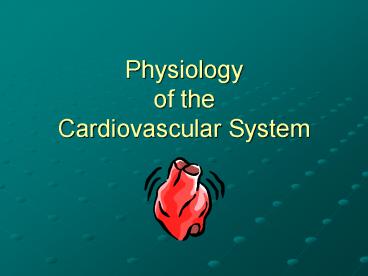Physiology of the Cardiovascular System - PowerPoint PPT Presentation
1 / 20
Title:
Physiology of the Cardiovascular System
Description:
Physiology of the Cardiovascular System The Conduction System of the Heart Modified cardiac muscle that specializes in contraction There are four main structures that ... – PowerPoint PPT presentation
Number of Views:298
Avg rating:3.0/5.0
Title: Physiology of the Cardiovascular System
1
Physiology of the Cardiovascular System
2
The Conduction System of the Heart
- Modified cardiac muscle that specializes in
contraction - There are four main structures that compose the
conduction system of the heart - Sinoatrial (SA) node
- Atrioventricular (AV) node
- AV bundle
- Purkinje system
3
Sinoatrial (SA) Node
- Initiates the mechanical contraction of the heart
(known as the pacemaker) - Located in the right atrium just below the
junction of the superior vena cava - Possesses an intrinsic rhythm. This means that
without any stimulation by nerve impulses from
the brain and cord, they themselves initiate
impulses at regular intervals.
4
Atrioventricular (AV) Node
- The impulse generated in the SA node travels
swiftly throughout the muscle fibers of each
atria. - The stimulated atria begin to contract they will
completely contract before the impulse reaches
the ventricles - The action potential enters the AV node by way of
three internodal bundles of conducting fibers
5
AV Bundle and Purkinje Fibers
- The impulse slowly passes through the AV node
then speeds up as the impulse is relayed through
the AV bundle (bundle of His) into the ventricles
- It is the right and left bundle branches and the
Purkinje fibers that conduct the impule through
the ventricles, causing them to contract
simultaneously.
6
Conduction System of the Heart
7
Artificial Pacemakers
- Devices that electrically stimulate the heart
- Electrodes sewn directly into the epicardium or
directly inserted into the heart chamber - Inferior to the hearts natural pacemaker
8
Electrocardiogram (ECG)
- Impulse conduction generates tiny electrical
currents in the heart that spread through
surrounding tissues to the surface of the body. - An electrocardiogram (ECG OR EKG) is a graphic
record of the hearts electrical activitythe
impules that preced the actual contraction - Electrodes are attached to a voltmeter and to the
limbs and chest of the subject.
9
(No Transcript)
10
Theory of Electrocardiography
- At rest (baseline)
- Action potential reaches the first electrode
(relatively negative) - Action potential reaches the second electrode
(pen returns to baseline) - End of action potential passes the first
electrode (relatively positive) - Action potential passes second electrode (returns
to baseline)
11
ECG Waves
- Represent the dynamic events that happen during
the contraction of the heart - Letters are arbitrary and do not stand for any
words
12
P Wave
- Heart wall is completely relaxedno change in
electrical activity - P wave represents the depolarization of the atria
13
QRS Complex
- Atrial walls are completely depolarizedno change
recorded - QRS Complex occurs as atrial walls repolarize and
ventricular walls depolarize (massive
depolarization of ventricles overshadows atrial
repolarization)
14
T Wave
- E. Atrial walls are completely repolarized and
ventricular walls are completely depolarized - T wave appears as the ventricular walls replarize
15
Back to Baseline
- Once the ventricles are completely repolarized it
is back to the baseline ECG
16
Bradycardia
- Slow heart rhythmbelow 60 beats per minute
- Slight bradycardia is normal during sleep and in
conditioned athletes when awake - Can be caused by damage to the SA node
17
Tachycardia
- Very rapid heart rhythmmore than 100 beats per
minute - Normal during and after exercise and during the
stress response - Can result from improper autonomic control of
the heart, blood loss, shock and a host of other
factors
18
Ventricular Fibrillation
- Complete disruption of the normal heart rhythm
- Death may occur within minutes if the heart beat
is not corrected by defibrillation or other means
19
(No Transcript)
20
(No Transcript)































